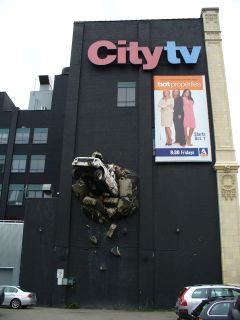Garry and I finally reached the damp and chilly shores of England on December 13, 2005. More than two months earlier, we'd flown out of Sydney, Australia on October 8, ready to start a new life in London. I'm relocating with my company, while Garry has bravely agreed to come along for the adventure. Our arrival marked the end of an incredible 2.5-month sabbatical, traveling through New Zealand, North and South America, and the Middle East.
Our trip was made using a really handy OneWorld Global Explorer round-the-world ticket. We'll complete the journey in April when we plan to fly back to Sydney via Japan and Hong Kong. With luck, Japan will be in the midst of cherry blossom season, making for some truly postcard moments.
The first half of our sojourn took us to the USA, Canada, Peru, Brazil, Argentina, Egypt, and Jordan. So many sights, so many memories. After a while, it all became too much to absorb. I'm sure we'll spend months indexing more than 5000 photos captured on the road.
I've shared more about our adventures in the first couple of dozen posts of this blog. If you start from the post titled Two decades of American Memories and read it down you'll get the full story on our world tour so far. The photo below gives you a taste of the many sights we experienced. This image was shot in Toronto.

Storage salvation courtesy of IKEA
I can't believe how time is flying by. It's hard to believe that we've already been in England for almost two months. I'm sure it was only a week since we were floating in the salty brine of the Dead Sea. Life has truly been a blur since we touched down at Heathrow. I've started work, we've opened UK bank accounts and permanent living arrangements have rapidly fallen into place.
Last week Garry and I finally moved into a three-bedroom flat located in the leafy suburb of Swiss Cottage. This literally involved packing the contents of a 40-foot moving container into a small three-bedroom English flat. English homes really are smaller on average than most in Europe (or at least that's what the Economist magazine tells me).
Needless to say, additional storage was required. Thank goodness for IKEA. We've emptied our wallets into its hallowed Swedish halls, bringing home shelves, cupboards, sideboards and all manner of items. These now hide a lifetime of accumulated junk.
On the ground, elsewhere
If all of this wasn't enough to stress me out, I had to fly to New York the day after we moved house. I was asked at short notice to help our US leadership team with a series of planning workshops. In the meantime, Garry had transformed the flat into a real home. Everything finally seems to have its place and our Australian furnishing looks like they were made for the flat. I arrived back in London last Saturday but then had to fly to Milan on Sunday to meet with my Italian team for the first time. I finally got back to London on Feb 1.
Since arriving I've also made trips to our offices in Munich and Paris. Five countries in as many weeks - this must be Europe! I have no more business travel now until Feb 16. I'll be off to Madrid for the first time. Garry is coming with me. We'll be staying the weekend as a belated Valentine's Day treat.
Jude Law's kinda place
Our flat covers the top two floors of a lovely red-brick mansionette. Swiss Cottage is relatively central, just north of Paddington Station (easy access to Heathrow for me thanks to the 15-minute Paddington Express), with good tube access to my office or the finance district for Garry. We have two movie theatres, three Live Theatres, and a gym within ten minute's walk of the flat. There are also plenty of great restaurants and exotic shops in the immediate area, plus Primrose Hill and Regents Park are only ten minute's walk south. All in all a great find in a great location.
I've been told Jude Law lives in the area. I've yet to see any sign of him, other than perhaps the turds his dog has left behind. Unlike Sydney, dog owners in London appear disinclined to clean up after their pets. Garry now spends his time feverishly scanning the pavement for wayward piles.
Aside from house hunting, we've also been busy catching up with UK friends and taking in plenty of live theatre. We've seen a witty comedy, a rock musical, and a traditional pantomime in our first month. As part of our RTW ticket, we fitted in a five-day trip to my brother's house in the Austrian alps at Christmas.
I stuffed up my knee the day before we flew to Austria. As a result, I never got a chance to test my ski legs. Garry did get in one afternoon of skiing and we all managed a session of night-time tobogganing on the last day in Austria. All in all the time with family was heaps of fun for all and a wonderful white Christmas (we had two feet of snow on the ground).






































































